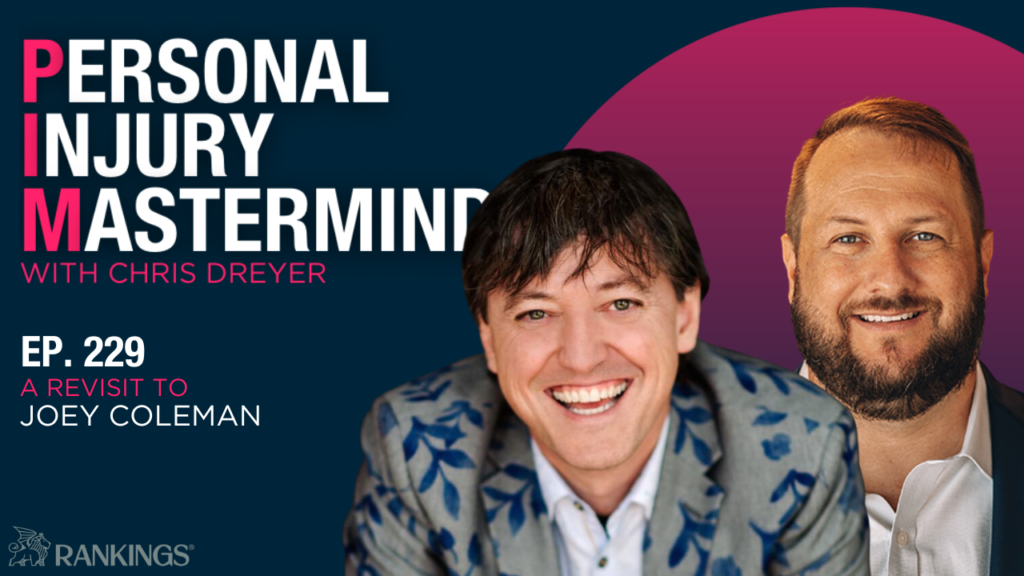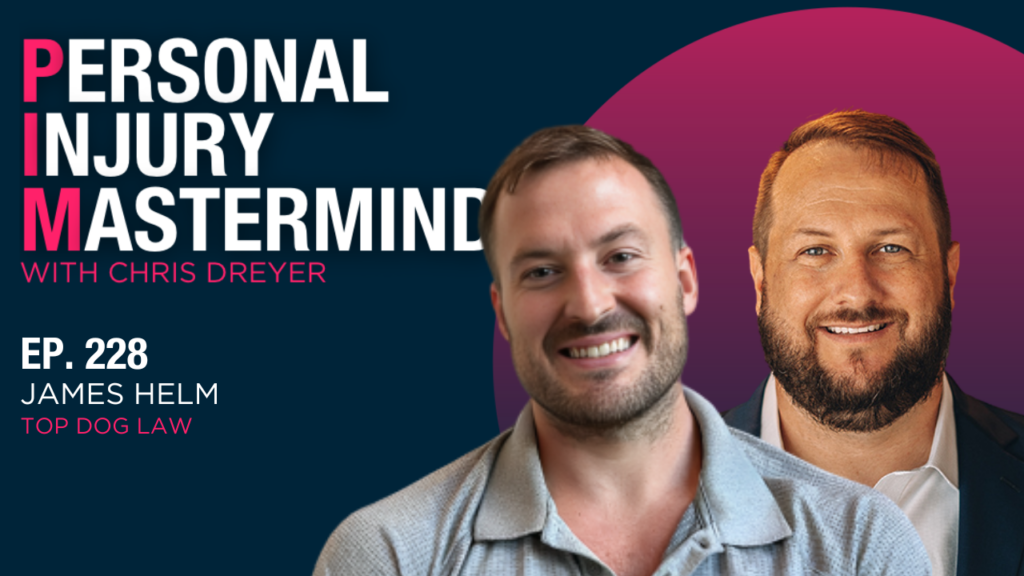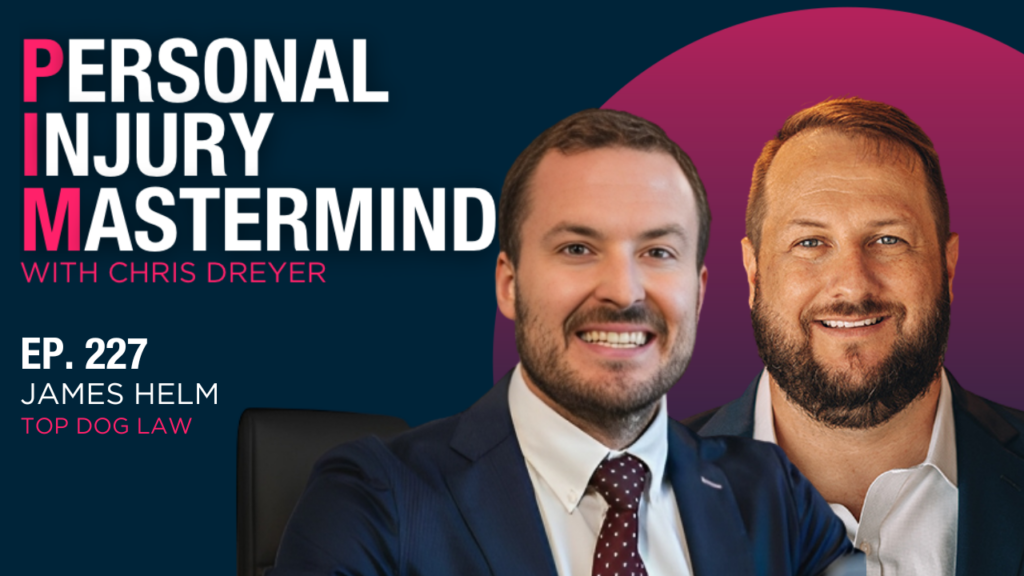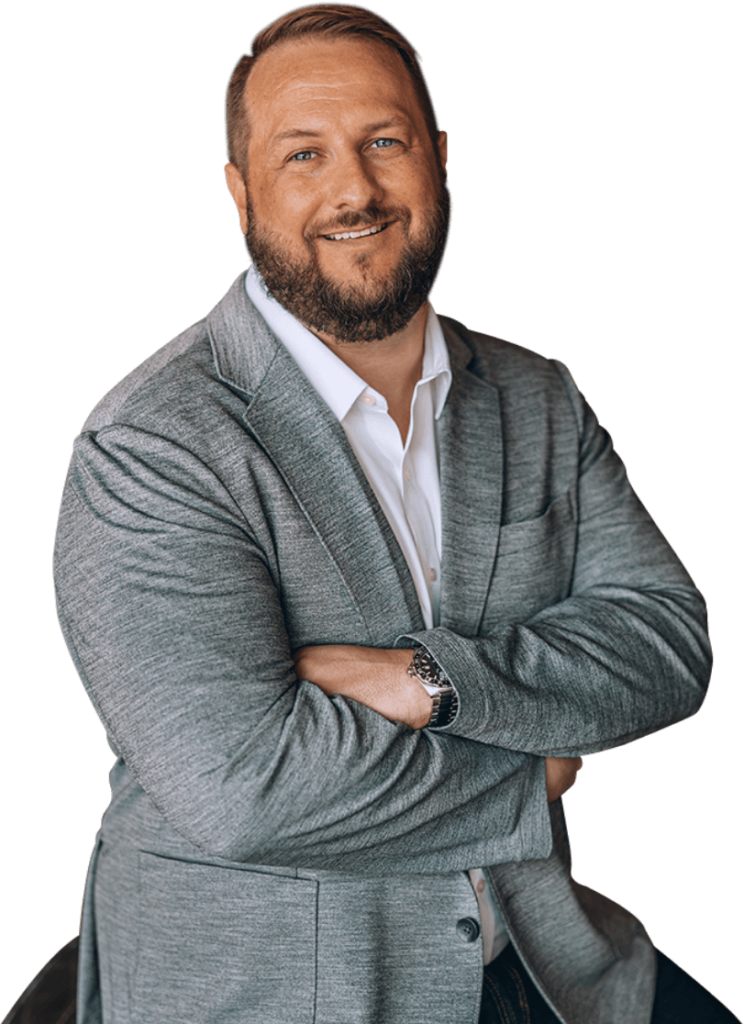Episode – Justin Croxton
Justin Q Croxton
It’s marketing malpractice to put all of your eggs in one digital basket just as if you put all your eggs in one basket, it doesn’t work. And your attorney you’re like, this isn’t going to work. This thing of marketing is horrible. Or this agency, or this company is not doing the right thing. No, folks need to be hit in multiple ways.
Chris Dreyer
Meeting the customers where they are sometimes literally is essential to a digital marketing strategy that attracts the right leads.
Justin Q Croxton
If you’re doing any form of digital or offline advertising, not even just geo-fencing, you have to have a site retargeting omni-channel site, retargeting strategy in play. I don’t care if you are. Doing $500 a month. I could care less. You have to have something because if you think about all the work that you may be doing with Chris and his team or anybody else that’s doing SEO or Google ads site retargeting helps make all of your marketing work that much smarter.
Chris Dreyer
You’re listening to Personal Injury Mastermind, where we give you the tools you need to take your personal injury practice to the next level. Since 2015, Justin Croxton has been the go-to guy for geo-fencing advertising and Omnichannel media marketing, CEO of Atlanta based Propellant Media, Justin is an Inc 5,000 entrepreneur and helps get personal injury lawyers directly in front of accident victims, I sat with Justin to understand the massive impact geo-targeting can have on revenue budgeting and the recipe for success in omnichannel marketing. I’m your host, Chris Dreyer, founder and CEO of Rankings.io. We help elite personal injury attorneys dominate first page rankings with search engine optimization. Being at the top of your game is all about understanding people. So let’s get to know our guests. Here’s Justin Croxton CEO and managing partner at Propellant Media.
Justin Q Croxton
I graduated from Morehouse college in Atlanta, Georgia started working in commercial real estate back in 2005. Worked in commercial real estate for six years. Decided it was time for me to go back to business school, ended up going to Stern School of Business up in New York. I was there for about two years. Full-time program. And while I was there, I really got fascinated with the entire digital marketing space. So instead of going into investment banking or, getting a law degree or anything of that nature, I said, I’m going to start my own digital practice. So at the time it was called Q Commerce. But since I moved back to Atlanta, formed an agency with a larger group of guys that is now called Propellant Media. And as you can imagine, Chris it’s tough, being an agency, you’re just trying to figure out how can I be different? And you guys have rankings.io. Y’all been incredibly different in such a great way, honing in on a personal injury attorneys and that entire space. And for us, we decided to focus on the geo-fencing marketing and programmatic display space specifically. We’re still do a ton of omni-channel advertising and supports it, but our go to market strategy was and has been. Geo-fencing advertising. And it’s on a content, it’s just being out there, being a thought leader. That’s really allowed us to grow the way that we have. And that’s really been our path thus far.
Chris Dreyer
Yeah. So anyone listening here? I don’t take the guests that I have on the show lightly. Justin is incredible. I’ve known him for geez, maybe five years, six years now, and a few masterminds of mine and. They do a tremendous job on the omni-channel marketing and just know how to market a business. And so you kick things off, So what is geo-fencing? What is, how is it different than just Google ads?
Justin Q Croxton
So geo-fencing marketing is the practice of targeting people in very precise areas. All the way down to the contours of the building.. So, if you can imagine with marketing, a lot of times, you may target a zip code. You may target entire city or a state, not everybody in that city or that state got into a, got into an accident effectively in those cases. But with geo-fencing, we can target individuals all the way down to the consorts of an individual building. So if we want to target individuals that went to an ER center let’s call it a towing location, a collision center. For example, those are real live case cases where we can actually draw a virtual fence around that location and serve ads to the people. At that individual location, essentially. So now you’re reducing your waste. You’re reducing the impressions that would have been allocated to people that you didn’t intend to target to begin with. And the one thing that I tell a lot of folks with geo-fencing is that it’s, it is different from Google ads and SEO, Google as an SEO is the holy grail when it comes to reaching people who are in market. Yeah. Truck accident, attorney, accident attorneys near me. That’s like someone like I need you now type of thing. Whereas with geo-fencing, we’re leveraging your location as giving us some insights into your intent to buy meaning. If you went to a towing location, No we’re expecting, there might be a chance that you may have gotten to a really bad car accident, or if you went to a collision center or if you went to an ER we’ll talk about the strategy of, one versus the other, but that’s really the comparison. And that’s how I define a geo-fencing advertising. Geo-fencing mark.
Chris Dreyer
Yeah, that’s super smart. I know your Atlanta and you’ll get a kick out of this. And my boy, Michael Mogill probably, if he’s listening, what we did was we dropped radio ads on a sports radio. Around the time of his Crisp conference. And we were also combo going to combo that with geo-fencing right at his location.
Justin Q Croxton
Yes. Yes. I know about Chris. Yes. Yes. That will. That’s, that’s exactly the point with geo-fencing like, if you know that your, all your audience is going to be at this location, then. Fence, boom. And everything else that you’re doing to feed the beast, feed them into your overall marketing funnel. So now super smart, super, super smart.
Chris Dreyer
What we talking about in a cost per impression, is it cost per click? Like how’s it structured? What kind of budgets are we looking at?
Justin Q Croxton
It’s this whole world of call it display advertising. So if you think about, it’s not true, it’s not Google display, but I know most people know Google display. So I’m just going to say Google display, but it’s really called programmatic display. Programmatic display. The formal definition is the buying and selling of ads in real time. Using automated machine learning effectively. So in this case, geo-fencing is leveraging your latitude longitude coordinate knowing that, okay, this person went to that location. So the ad server is going to say, you won the bid. You are going to serve an ad to that person from their mobile device ID, essentially that’s the formal definition of programmatic display advertising. And the reason why I bring that up. In many cases, it’s really based on a cost per thousand impression model. It’s not traditionally a cost per click model as comparison to Google ads or Google display, even it’s really more so a cost per click model. And in those instances, Programmatic display geo-fencing is the CPM model. Usually, our say our CPMs range you can have some CP rates, CPMs that can be, around six bucks. You can have some CPMs that and go all the way up to 14. And certain instances just really depends on the situation.
Chris Dreyer
CPM model. Just for those listening. It’s very common. Common. If any, if someone, if you’re listening and you’re saying, Hey, I want to put sponsor a podcast. And those CPM models are typically 25 to $50 per CPM. And what you’re saying is, so when I hear six to 14, im, thats low. yeah , because not as many people are doing it. Why is it so low?
Justin Q Croxton
It’s more of a supply and demand type of issue with someone who’s, if you’re looking to sponsor a podcast, there’s a little bit more control over that supply and demand ratio. If you will. And so you can charge a little bit more and, I’m sure there’s a lot of podcasts out there. It’s just like the costs of normalize to that $25 range that you mentioned. Whereas in the programmatic space, the range is really aren’t, as onerous on an attorney or a brand, for that nature. And so strategically, and now we’re getting into this, like some good strategic stuff right now, typically for me, If you have video content, I’m telling you leverage that video concept. If you have, if you’re an attorney that has done some form of TV spots, you need to really leverage those for over the top connected TV advertising, because you can actually leverage that with geo-fencing addressable geo-fencing. And I’ll talk about a specific strategy of what we did in that case. But if you’re talking about static banner ads, those are the clickable ads that most people will see. If everyone that’s out there, you take out your mobile device. You go to the weather channel. That is an actual ad that shows up that could be essentially one of your ads effectively. Those are going to range about, let’s call it, let’s call it six to 14 bucks. Let’s just putting that out there. There’s some platforms that charge a lot more of this, on that charge. A lot less, depending on how much you’re spending. But if you’re looking to do video. Pre-roll video, it’s still relatively inexpensive. You’re closer to 15, some people charge 20 bucks now with OTT advertising. Those are the streaming apps that are out there. Now you’re closer to about 40, sometimes it’s a little bit more, sometimes less depending on the scenario. But again, it’s not an onerous spend and it’s an incredible compliment to a lot of the lower funnel digital strategies that you’ve implemented for your practice effective.
Chris Dreyer
over the top advertising or OTT includes all the banner ads that you see over streaming services like Hulu or CBS. I asked Justin to walk me through a hypothetical scenario in which a firm places a geo-fence around a hospital in Houston. What happens when someone who has been in a car accident enters the fenced area?
Justin Q Croxton
Perfect. I got into a car accident, I’m hurt pretty bad. Some of my loved ones they’re coming to the hospital as well, makes her and I’m okay. My phone happens to be on me. My phone is on, let’s say you, your personal, your attorney, you built this virtual fence around this one hospital. Let’s call it the moment that you walk inside that virtual fence, we’re able to capture your mobile device ID. All phones, all phones have that mobile device ID essentially. The moment that you walk inside that virtual. We are then able to start serving ads to you. Now it’s not text messages. So a lot of people misconstrue that it’s not like I’m now able to text message you or anything like that. It’s more of a passive experience. So the moment that you happen to go on mobile apps and websites, that’s when you’re able to start seeing ads from that attorney or whomever. So if you think about angry birds words with friends, the weather channel, Fox news, CNN the daily mail, a lot of those streaming apps and websites that are out there that’s the moment in which we’re able to begin serving ads to that user that we captured inside of that virtual fence. And we can target you both while you’re inside the fence. And then for up to 30 days, sometimes even longer than that, after you have left the fence, So it’s just like traditional site retargeting for those who don’t know site retargeting is when someone comes to your website, they then leave and then you start seeing ads everywhere. It’s the same concept, but we’re leveraging your location. And then serving ads to you for that period of time. That’s essentially the overall process of geo-fencing. That’s what it looks like. Okay.
Perfect explanation. If you’re a personal injury attorney and you’re listening and you want to do retargeting on say Google has restrictions on that. So that’s how you get around this. You can’t retarget. You used to a few years in the past. You could even maybe slip in on ad roll, but so talk about how that’s different . A lot of the ad exchanges that we have access to are just provide a little bit more leniency. Now I will say that like you have a Google display network and they’re saying, no, we don’t let any attorneys, whether it be a bankruptcy attorney that wants to do. Like display advertising or retargeting, they’re a little bit more restrictive, whereas we have access to many different ad exchanges through our, through programmatic display in general. And so with geo-fencing. The restrictions just aren’t there. They’re saying if you got into an accident, it’s not like I am, geo-fencing an abortion clinic. And I’m telling you that you can no longer have of having an abortion, that type of thing. Or you’re a cancer patient. And I have this cancer prod is cancer healing product, and I’m targeting you based on your prognosis. This is more targeting someone who may have bought to a car accident and that’s it effectively. And so I, the reason why I bring that up is because in, and this is really important. I really want to stress this to a lot of attorneys, but everybody that’s out there, if you’re doing any form of digital or offline advertising, not even just geo-fencing, you have to have a site retargeting omni-channel site, retargeting strategy in play. I don’t care if you are. Doing $500 a month. I could care less. You have to have something because if you think about all the work that you may be doing with Chris and his team or anybody else that’s doing SEO or Google ads site retargeting helps make all of your marketing work that much smarter. A lot of people aren’t going to become a customer in that very first click moment. They’re just not. And so a lot of times, 60, 90 days after the fact. And that moment someone got into a car accident like me. I didn’t realize my extremities where that bag, golly, I’m sorry. All of this internal bleeding and go, I really need to reach out to somebody. And then at that point, They see your ad, they’re like, oh, wow. I didn’t think about these guys. Let me reach out to them now. And again, it makes all of your marketing work smarter. So don’t be as concerned with the Google display. There’s a lot of other ad exchanges, but to, I just, it’s not like I can just get a little passionate. I really wanted to stress that, but the geo-fencing still allows you to do a different form of retargeting. It’s just leveraging your physical location. So
Chris Dreyer
Much like traditional marketing or billboards or TV ads geo-fencing is a solid brand play. I wanted to know how geo-fencing is different and how it can target an ideal audience. ,
Justin Q Croxton
If you think about TV and traditional radio, you’re not able to really target an individual with that level of specificity. Hey, I know that if I created a strategy that targeted all of the towing locations and collision car centers and ERs, within the city, You know that’s you can’t target those individuals with TV advertising. You got to target everybody with TV advertising with it, which where differently with geo-fencing, where you can actually do video OTT advertising and static banner ads to those locations, helping you build the overall funnel of individuals who could have possibly been in an accident in some capacity.
Chris Dreyer
I think that’s a great explanation. if I’m talking about an SEO strategy, I’m going to say, Hey, if you do local service ads, you do Google ads, you do local SEO. Do you do organic SEO? Now? It’s you’re in there. They see you multiple times. I would say there, there could be a flywheel effect. You combo with a content marketing strategy and they all kind of work together. They elevate each other. what are your suggestions? what type of investment they looking for in a small market, in a big market. What should just be there, the general thought process around this?
Justin Q Croxton
We have some attorneys that will do, three to 5,000 small markets, and we have some that will do close to 10 to 20 and some of the larger markets even if they just want to have a standard presence. So those are just some sample just packages and that’s on a per month basis, let’s call it. And the recipe. For success. Let’s just look at it from that perspective is that, we’ll do in one thing that I do want to mention to folks that, and a lot of times for us we’re thinking about how are we reducing waste? For any client. And so some people will naturally think that targeting ERs and putting all of their money towards an ER is the best option, but is actually not the best option. Part of the reason is if you think about how many people went to that, ER actually did get into a car accident, right? So like maybe a hundred, like a hundred people that went to an ER, maybe two, maybe three, possibly. Whereas on the flip side, if you targeted a towing location, maybe the ratio is like for every 10 people, two or three. So now you’re talking about closer to 30. There’s less people, but. It’s a higher ratio, same thing with car collision center. So you want to have a nice mix in locations that you’re targeting from that perspective. And that gets down to the campaign infrastructure in different campaigns that you create. So there’s that part of it. And then we also have a couple of clients actually. Where they actually get a list of folks that got into a car accident? Actually, there’s like a like some databases that are out there where we have this product that’s called addressable household geo-fencing or CRM retargeting, where we’re able to take someone’s address city, state, and zip code. And then, it’s the same geo-fencing technology. But except that we are building a virtual fence around their home and then serving ads to those individuals during that period of time as well. And so between those, between that potential combination of geo-fencing and addressable geo-fence thing, and also slapping like another $500,000 a month towards omni-channel site retargeting, whether it be, some Facebook and Instagram retargeting as well. Programmatic site retargeting. I think that’s a pretty good recipe for success, and that’s going to help feed the beast with all the other things as an attorney that you might be doing through SEO, google ads we’ll add in your overall content strategy to really nurture the heck out of folks who are trying to just get some answers and feel like they can find somebody that they really can trust and, help potentially win their case.
Chris Dreyer
It just seems like a really good overall strategy to compliment a lot of efforts. Because even if you’re doing the traditional TV, will they, they’re gonna, they’re going to go to Google and convert typically on your website. You’ve touched on omni-channel marketing. What’s funny is you mentioned the holy Trinity of SEO and that’s actually the title of one of our previous podcasts. from an ROI perspective, from a marketing strategy, how do you see omni-channel marketing on digital and some general recommendations and you’ve already hit on it, but I want to give you a little bit more open paltform here.
Justin Q Croxton
I typically tell a lot of folks to try to focus as much on those lower funnel, digital tactics from the Google ads, to the SEO, to the Facebook. Instagram advertising, cause there’s a lot of great lookalike audiences that you can build off of that have a real appreciation for that particular part of the space. Also on top of that, we’ll tell certain clients to have, more of an omni-channel site retargeting strategy. So when I say omni-channel, I know that’s okay. Omni-channel is like Google ads and Facebook and Instagram, maybe LinkedIn. But then you have. Omni-channel site retargeting, where you’re reaching people across multiple digital platforms from a retargeting perspective. As I was mentioning earlier, programmatic display site retargeting a Facebook and Instagram site retargeting for some of our clients that might be in the B2B space or other spaces. You may have LinkedIn site retargeting. You can actually do LinkedIn site retargeting, essentially. Think of any other channels out there. You can even now do site retargeting through Tic-Tok even, go figure just having, A much more comprehensive game plan. And I think this is where, Chris, you and I, we, we connect on this concept of marketing malpractice, it’s marketing malpractice to put all of your eggs in one digital basket just as if you put all your eggs in one basket, it doesn’t work. And your attorney you’re like, this isn’t going to work. This thing of marketing is horrible. Or this agency, or this company is not doing the right thing. No, folks Need to be hit in multiple ways and everybody consumes content or gets their questions answered in different ways. Some people get those questions answered on Instagram and Facebook, and sometimes they’re more comfortable to convert on a Facebook or an Instagram versus Google ads or search. So that’s why for us, we tell brands all the time, do not put all of your eggs in just one basket, do multiple things. You can still be smart about it and then put more of your funds towards those lower funnel tactics. That’s usually the conversation that we have with folks. And then, then you measure, you put up all your conversion tracking through your chat, through your forums, through your phone calls, all of that set up, multi-touch attribution, see how everything’s, rock and roll in and then, keep it moving and then go from there.
Chris Dreyer
An incredible piece of advice the one thing that I, all the big TV advertisers that don’t do digital, unlike licking my lips, I can’t wait because when they have, when you have a brand, you’re your click through rates can be impacted, which in turn can help the SEO. So they, there’s a lot of different advantages and complimentary things, but I just have to reinforce this. And Justin, we, I think we’ve crushed it on this. OTT geo-fencing omni-channel marketing. And I want to, what’s next for Propellant Media? Where can people go to learn?
Justin Q Croxton
If you have questions, if you’re just trying to just consume content, just learned about the space in general go to www.propellant.media. I will forewarn you that if you go to the site and you will start seeing our ads everywhere. It’s going to happen. Unfortunately, Chris, I know you’ve experienced that. We practice what we preach, what can I say? But we really just try to have our site be more of a resource, a learning module for a lot of folks that are out there. And if there’s questions you need anything, just let us know.
Chris Dreyer
Omnichannel marketing, retargeting and programmatic display can help your firm gain the competitive edge to win your next client. Whether you’re targeting rooms within buildings or whole states, geofencing will increase exposure to the right audience and reduce ad spend waste. I’d like to think Justin Croxton from Propellant media for sharing his story with us. And I hope you gained some valuable insights from the conversation. You’ve been listening to Personal Injury Mastermind. I’m Chris Dreyer. If you liked this episode, leave us a review. We’d love to hear from our listeners. I’ll catch you on next week’s PIMM with another incredible guest and all the strategies you need to master Personal Injury Marketing.


























